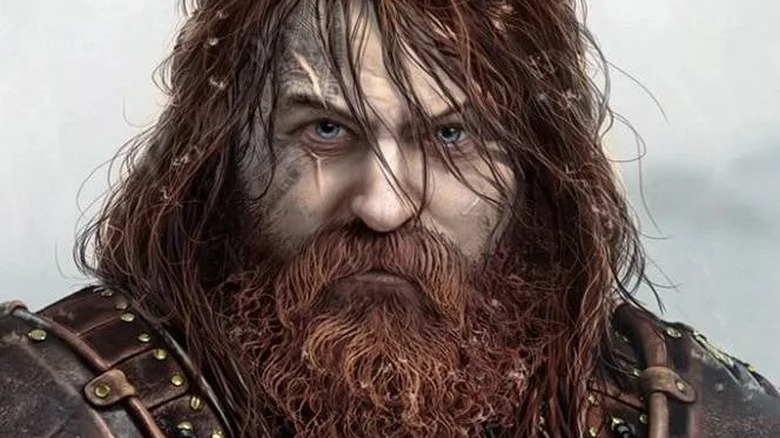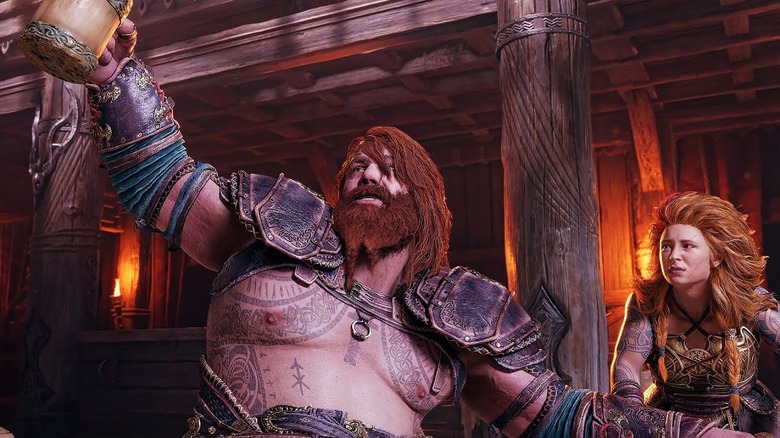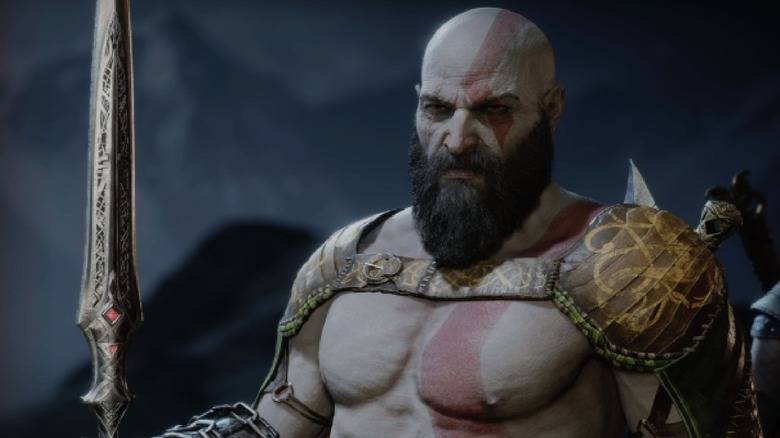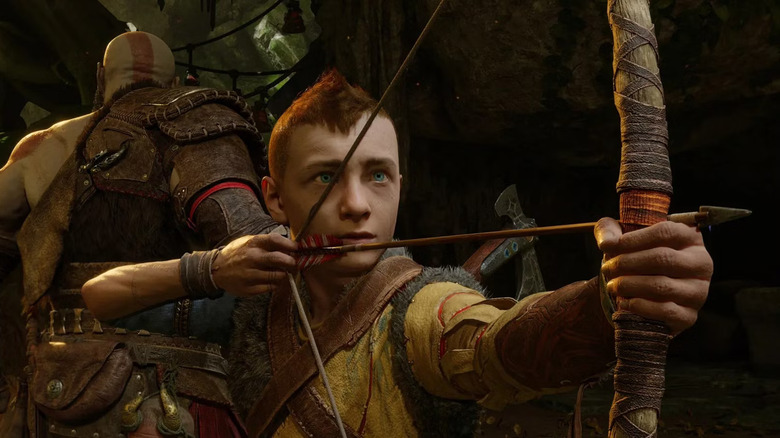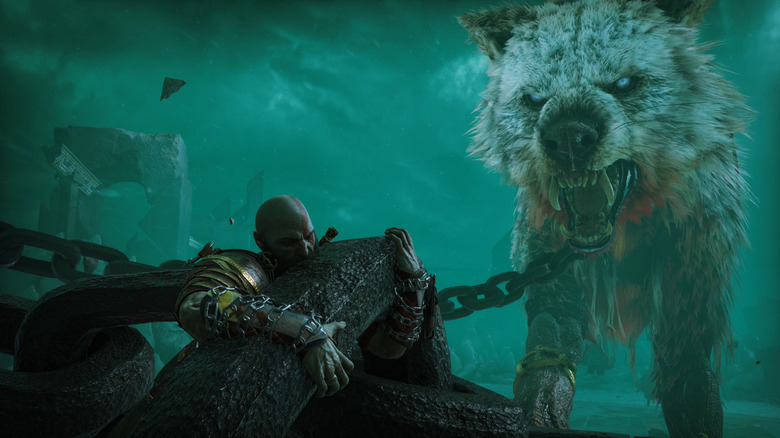How The Sounds In God Of War Ragnarök Were Really Made
Have you ever wondered why it takes so long to develop a video game? The production process incorporates several elements ranging from story and gameplay to user interface and sound design. Each of these elements encompasses its own sub-categories and departments, all aimed at enhancing the player's experience and connection to the game in question.
While all aspects of development bear importance, sound design plays a crucial role in tapping into the emotions of a player. Players often expect people, places, and actions to sound a certain way; not meeting those expectations can ruin the immersion. In contrast, thoughtful sound design can breathe life and personality into a location, scene, or character.
"God of War Ragnarök," the sequel to 2018's "God of War," serves as a prime example of the power of sound design to enhance a player's experience. The title won multiple awards following its release, including the BAFTA Games Award for Audio Achievement and The Game Award for Best Audio Design. To hit on this success, the audio team worked for months to capture and mix its own sounds before painstakingly incorporating them into each "Ragnarök" scene. The process used to make these sounds may surprise many players.
The power of everyday objects
To enhance the immersion of their games, artists turn to a process called Foley to create sound effects for a scene within a piece of media using a collection of props. These individuals use a surprising array of everyday objects to mimic the sounds of other items or actions. This approach played a major role in the sound design for "God of War Ragnarök."
Foley Artist Joanna Fang created some of the effects for the project. Fang took Wired behind-the-scenes into the PlayStation Foley Studio, a place filled to the brim with seemingly random props. She highlighted several combinations of objects that mimic the sounds of other items when they interact:
-
Indian para knife + torque wrench = assault rifle
-
Stepping on lump charcoal = walking on snow and ice
-
Pistol holster + manicotti shells = bone breaking
-
Fist + melon = "gory viscera sounds"
-
Toilet plungers + stone = galloping horse
Fang said the key to Foley is maintaining an open mind regarding the possible utilization of an object. The artists can't limit themselves to an item's traditional usage. "It's like weaponizing ASMR, you know what I mean? Like we're trying to get the audience to feel something," she explained. She further described Foley as "a very powerful performance art language that connects the audience with the characters." It helps get viewers or players invested in what's happening in the story.
Creating one of Ragnarök's most complex scenes
As part of the Wired feature, Fang demonstrated how sound design can create two different feelings for the same scene depending on the genre the creators want to target. She showed how she put Foley to use in the "bar brawl" sequence from "Ragnarök" by recreating some of the sounds in the studio.
Fang used a sword, crowbar, and pieces of wood to create the sounds of the characters removing their weapons. Later, she utilized a shipping pallet and wooden planks to highlight Atreus falling off the second floor of the building. Fang manipulated a leather jacket to convey Atreus' attempt to escape the grip of the bar's bouncer. To depict the moments leading up to a "head smash," she twisted a wet rag, tore some lettuce in half, broke manicotti shells inside a holster, crushed a can, and split open a melon with a crowbar.
"On a sequence as complicated as bar brawl, we're creating over a thousand assets, easy," she expanded. "Foleying a game takes months and months and months because of the sheer density, attention to detail, and contextual storytelling that we have to do on the Foley stage." Despite the level of effort and coordination required, Foley only represents one facet of the sound design process.
Imbuing Kratos' new equipment with unique identities
As revealed in an interview with A Sound Effect, the designers preserved many of the sounds from "God of War," tweaking them in some cases to work better with the new technology and story elements of "Ragnarök." Due to COVID-19 restrictions, the team had to devise fresh strategies for putting together the effects it needed. Many people captured sounds during solo recording sessions at their homes using household items. They even spent some time recording in a junkyard for "metal impacts and detailed debris," according to Stephen Schappler, the sound design lead for interacts and puzzles.
Pulling off such in-depth audio design required careful organization. Sound Design Lead for Gameplay Moments and Set Pieces Justin E. Bell created a massive Excel spreadsheet that he dubbed "Pathmaker" to keep track of all of the relevant data. Thanks to this attention to detail, the team was able to accomplish feats like imbuing pieces of equipment with unique identities.
For Kratos' new Draupnir spear, they used "different types of metal and whooshes" along with "processed wind and bottle rockets" to distinguish it from the Leviathan Axe and Blades of Chaos. Players can also see this approach exemplified in the four shields the developers added to "Ragnarök" for Kratos.
"Eric Williams, the game's director, gave perfect advice as a starting point: Make them so identifiable that they could be used as onomatopoeias if translated into comics ... like 'THWIP' and 'SNIKT,'" explained Bryan Higa, the sound design lead for player characters: Kratos & Atreus. "We assigned descriptive titles for each shield that helped describe the feeling and size each should sound like; Dauntless Shield: Switchblade, Stone Wall Shield: Thick Door, Onslaught Shield: Solid Hammer, Shatter Star Shield: Rusted Cannon."
Distinguishing Atreus from his father
With the addition of Atreus as a playable character in "God of War: Ragnarök," the sound designers had to forge ways to distinguish him from his iconic parent. While Kratos focuses on raw strength, Atreus takes a more dextrous approach infused with what Higa described as an "empathic sense of wonder." To help Atreus stand on his own, the team created new sounds for his arsenal and combat moves.
Multiple recording sessions went into the Sonic Arrows utilized by Atreus. "We used elements of whip cracking and sling-shotting bullet casings and paperclips out in the Painted Canyon in California," highlighted Higa when speaking to A Special Effect. The team started on these projectiles early in the process, and they went through several versions throughout the multi-year development cycle (via SoundWorks Collection). An array of departments came together to produce the final sound effects experienced in "Ragnarök."
Atreus also got his own shield with a distinct feel to it. "We pulled source from metal and crystal singing bowls, glassy sand debris, sparkles and sizzles, and some processed synthetic warbles to give it an otherworldly feel," Higa said. "Overall, our goal was for Atreus to feel a little more mystical, tonal, and youthful compared to Kratos while still keeping his father's aggressiveness and power."
Making Ragnarök's bosses 'larger than life'
Much like with Kratos and Atreus, the sound designers spent a great deal of time creating distinct audio for the bosses in "Ragnarök." Supervising Sound Designer/Mix Supervisor Michael Kent highlighted Thor as one of his favorite challenges to work on. The process required the cooperation of multiple individuals to pull off, including Fang and her flair for Foley.
"From the tonal whooshes of Mjolnir to his bigger thunderous attacks, we put a lot of detail into [Thor's] sound and as the moves get bigger so does the sound design," Kent divulged to A Sound Effect. To produce just the right feeling, the group turned to an interesting array of objects. "A lot of the electricity used on Thor was a plasma ball recorded with a popular transducer microphone running through a modular rig. This was combined with cellophane and processed duct tape to get the sound you hear in-game for the electricity on his hammer."
To portray Garm as what Sound Design Lead for AI Cast Beau Jimenez dubbed a "gargantuan terror," the team drew on recordings of different objects and animals, not just wolves. The list included "horse squeals" and "sea lion roars" for some moments, while the movement of rocks and even explosions contributed to other attacks. For Odin, they focused more on a "magic sound palette that evoked an ancient and evil aura," according to Jimenez. A wealth of sounds went into this encounter, including hitting concrete with a crowbar to represent his staff striking the ground.
While the individual elements of the audio design might seem small, they combine to create an impactful whole that secured an outpouring of accolades for "God of War: Ragnarök."

